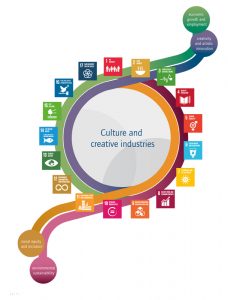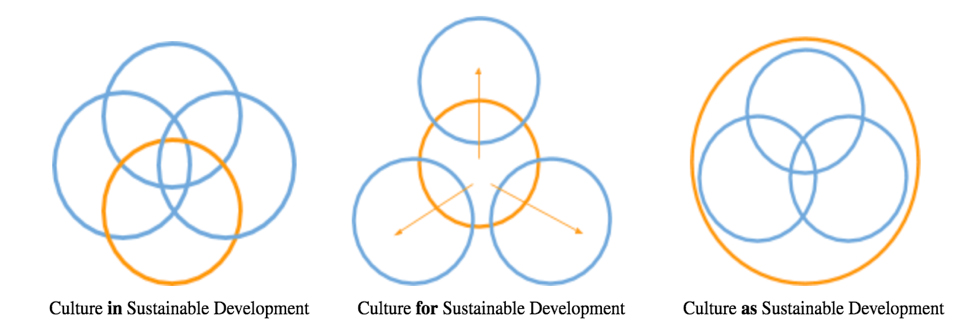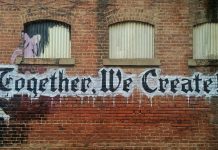Maastricht – In the last years the talk has been on sustainability and creating development opportunities amongst all countries (developed and developing) around the world, to end poverty and to put the human being as the central component for policy making.
From local governments to international organizations, the role of culture and creativity is gaining more insight and recognition as vital tools to solve current challenges within our communities. This week we will explore the role of culture in the sustainable development cycle. Considering the imperial role of the Sustainable Development Goals (SDGs) on Aruba, we will learn more on the possible contribution of culture and creativity on the socio-economic development on the island.
The SDGs or the Global Goals for Sustainable Development are collection of 17 global goals set by the United Nations General Assembly in efforts to end challenges such as poverty, gender inequality, climate change and to stimulate economic growth, education and health care for all. These 17 goals have been structured through a range of 169 targets and many indicators. Aruba, as a member of the Dutch Kingdom, pertains to the implementation of the SDGs since 2015.
In the case of the Cultural and Creative Industries (CCI), most SDGs are relevant and have influence on further developments within a CCI. For instance, CCIs can be connected to goals targeting inclusivity, cultural heritage preservation, entrepreneurship, skills training for the youth, the use of technology and creativity to solve social problems in resilient societies, such as Aruba. The previous and the current government of Aruba have both expressed their interest in developing a CCI on Aruba. Since 2016 it has been on the list as a potential economic pillar for the island with the goals of diversifying the local economy.
The contribution of the CCI can be reflected on through economic, cultural and social development aspects. Related to the SDGs, the CCI can identify itself with three different SDGs which are; SDG 8.3 (economic development), SDG 11.4 (cultural development), and SDG 4.7 (social development).
- SDG 8.3 emphasizes on the promotion of development-oriented policies that support productive activities, decent job creation, entrepreneurship, creativity and innovation, and encourage the formalization and growth of micro-, small- and medium-sized enterprises, including through access to financial services.
- Next to this, SDG 11.4 focusses to strengthen efforts to protect and safeguard the world’s cultural heritage.
- Lastly, SDG 4.7 seeks to ensure that all learners acquire the knowledge and skills needed to promote sustainable development, including, among others, through education for sustainable development and sustainable lifestyles, human rights, gender equality, promotion of a culture of peace and non-violence, global citizenship and appreciation of cultural diversity and of culture’s contribution to sustainable development.
Culture and Sustainable Development

Now, going into the more theoretical aspects of sustainability and culture. Duxbury, Hosaghahar and Pascual (2016) elaborated on the concept of sustainable development as it occurs to cultural dimensions within societies. Upon analysis of the streets of the cultural city of Aruba, San Nicolas, the very public expression of its community states “we culture”. People feel very connected to their culture, because it is part of their past, present and future. It is evident that culture is significant to human development.
Now, Duxbury et al. indicates that there are three ways sustainable development is related to culture. The first one is when “culture is IN sustainable development”. Here, culture is added as a separate pillar, equal to other pillars in the economic, social and environmental sectors. In this situation, culture plays a major supportive role in a society and is considered an asset. The second way is when “culture is FOR sustainable development”. Here, culture is the mediator between the economic, cultural and social sectors. Lastly, there is “culture AS sustainable development”. Here, culture has the position of being the foundation of development.
What about Aruba?
Considering the Aruban cultural sphere and heritage, the role of the SDGs globally is to transition from “culture in sustainable development”, the more traditional view of culture, towards “culture as sustainable development”, the more contemporary view of culture within societies. However, the task for Aruba is to identify which direction it will take going further. Currently, culture stands as a separate entity and is not directly inclusive, even though, this is slowly changing.
It is important for our community to be involved in this process. Culture and creativity, as dynamic as it is, will need to be integrated within our economic, educational and social national policies. The idea of culture AS sustainable development is the outlook of inclusion. The aim is to use culture and creativity as a tool for innovation to inspire the next generations. As well as using culture and creativity to safeguard the Aruban cultural heritage. The contemporary cultural facets to preserve the past and to innovate towards the future. Now, I have a question for you. As we say in Papiamento; cultura DEN, PA of COMO desaroyo sostenibel? What do you think?















